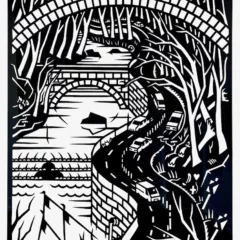[Michael is beamed up into a collection of work inspired by the Air Force’s questionnaire on UFOs, where time seems to pass more slowly. — the Artblog editors]
This month, Space 1026 transforms into a green-tinted, black-light paradise that is an X-Files-lover’s dream. Ben Furgal’s Describe the Phenomenon presents evidential collages and paintings whose titles come from the Air Force Form 117 questionnaire about Unidentified Flying Objects.
“Remain calm and objective.”
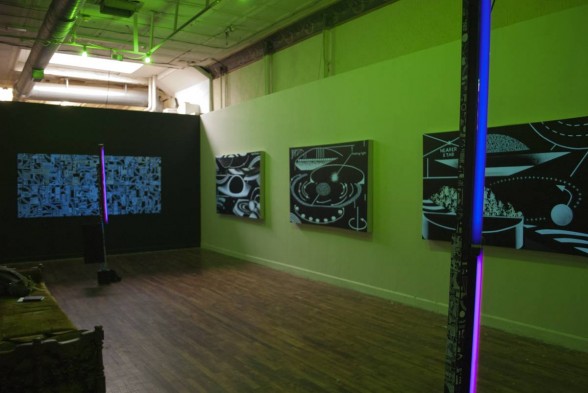
Furgal replaced the overhead lights with neon-green florescent lightbulbs that add an eerie glow–similar to something out of an alien-themed haunted house. These lights radiate off the futuristic black-light cell-towers, which are free-standing and weighted down by spacey rocks. The combination of the two types of lighting sets an extraterrestrial ambiance for the artist’s work.
In each piece, Furgal responds to the Air Force questionnaire, and with each painting and sculpture, he depicts his own visual account of a UFO sighting. The artwork progresses as a pictorial narrative in response to each question that further illustrates the scene Furgal is painting.
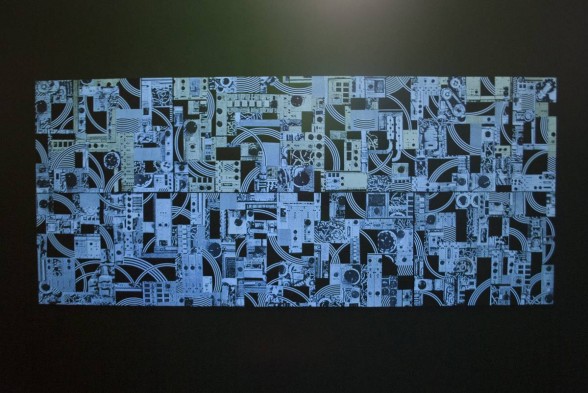
His first response to the questionnaire is “A Structure In the Air,” a four-panel painting and collage emulating the tangled wires and copious number of knobs, switches, and light bulbs you would expect to find in the cockpit of a plane. This painting, like the rest of the work in the exhibition, relies heavily upon its title to clarify the intent of the artwork.
In “A Structure in the Air,” Furgal has fashioned an abstracted mechanical circuitry board that disorients the viewer. He reminds viewers in his artist statement to “remain calm and objective” in order to make sense of all the visual information he has provided. What do we see? The inner workings of a structure in the air.
“Draw a picture of what you see as accurately as possible.”
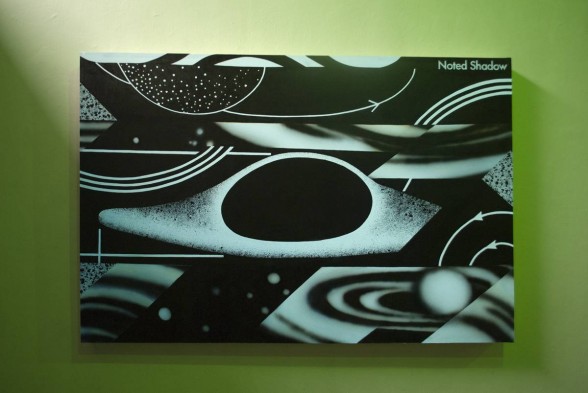
To the right are three equal-sized paintings that directly respond to their inquisitive titles. Take “Did The Phenomenon Move Behind or In Font of Something?”, wherein Furgal rejects a singular answer and instead blurs the lines between the planes within his composition. The viewer is left to decide whether or not the analogous hard-edged sections are in front or behind their neighboring hazy areas.
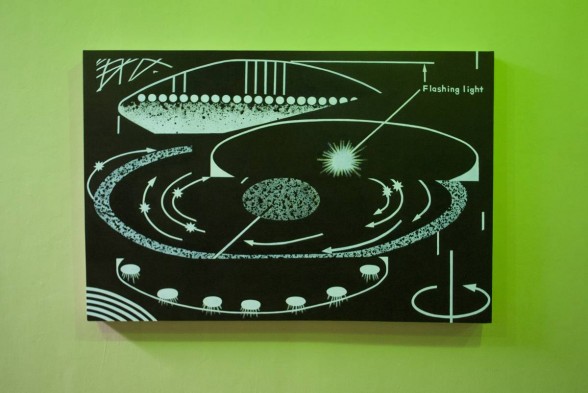
“Did The Phenomenon Spin Like a Top?” is not all that different from “Did The Phenomenon Move Behind or In Front of Something?” in its approach and style, but here there are more found images in the collage, from Form 117, astronomy textbooks, and UFOs–note the starburst and arrows indicating the orbit path, and created forms, such as a UFO-like object in the upper left-hand corner.
“Indicate whether it reflected light, or was self luminous.”
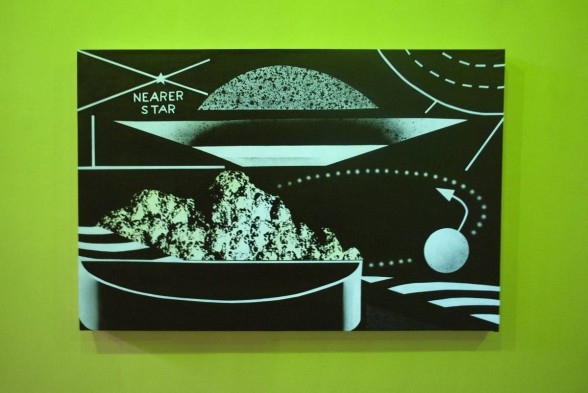
The artist concludes this series of three paintings with “Where Were You When You Saw The Phenomenon?”, in which Furgal includes a collaged image of a rocky formation directly referencing an illustration in Form 117. Of the three interrogatory-response paintings, this piece lacks the playful retort-like quality of the other two. But that said, as a group, the three stand as the most visually challenging compositions that directly relate to their questioning titles.
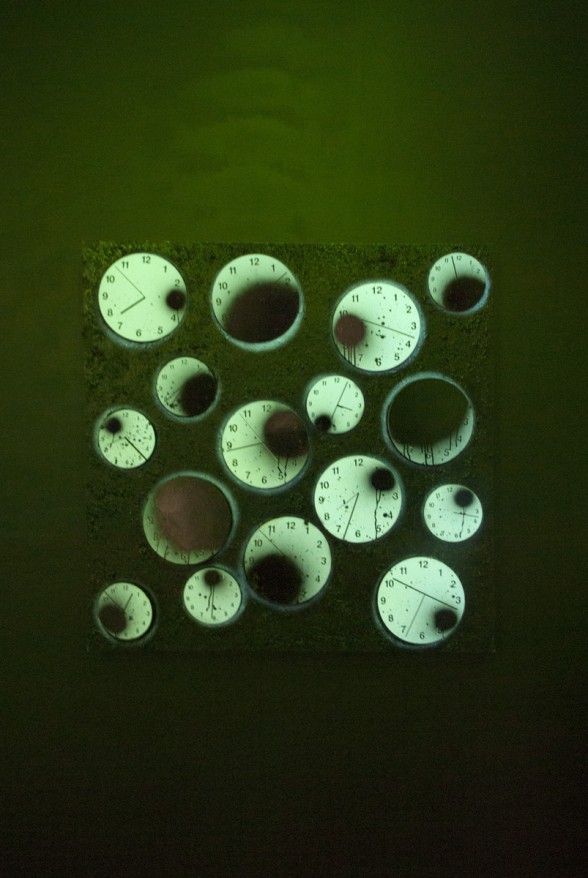
The artist tackles the obscure timeframe of his alien encounter with “Missing Time,” as if to say that there was a lapse in time after his sighting of a UFO that supposedly spun like a top. With this lapse of time in his story, and the inclusion of easily recognizable objects in his sculpture, like clocks and rocks, Furgal opens up a whirlwind of possible narratives for the viewer.
“If there is any physical evidence left, containerize it to the best of your ability.”
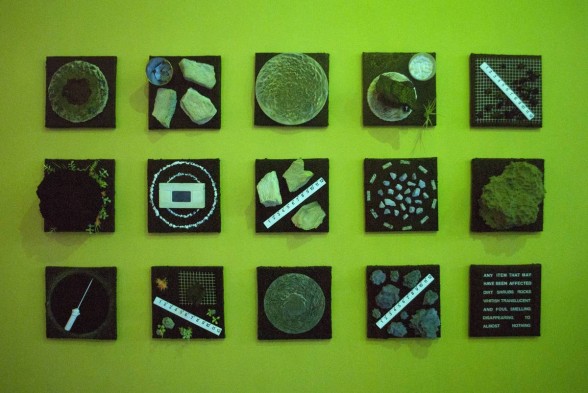
“Did The Phenomenon Leave Any Physical Evidence?” also includes objects, that, like the clocks in “Missing Time,” let the mind wander with possibilities. “Physical evidence” is displayed in a series of 15 square panels with rocks, plants, and futuristic objects that are measured for scale and on display.
Furgal’s inclusion of the collection of evidence enticed me to wander through the exhibition multiple times, as if further developing the hidden narrative within the work. The evidence suddenly added a reality fix to the show that caused this viewer to pause and think.
Describe the Phenomenon is an opportunity for viewers to immerse themselves within the tale of a UFO sighting, or to criticize the absurdity of such an event. It is a mentally stimulating exhibition that immerses visitors in a surreal conspiracy and asks them to develop a narrative from the responses visualized in each artwork in a unique and entertaining manner.
Describe the Phenomenon: Paintings and Sculptures by Ben Furgal is on display at Space 1026 from September 5 – 28, 2014, at 1026 Arch Street 2nd Floor, Philadelphia, PA.





